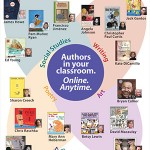Blog Tour: Adele Griffin
Today, TeachingBooks.net welcomes author Adele Griffin as she stops by on her blog tour.
“If the child gives the effect another turn of the screw, what do you say to two children?”
“We say, of course,” somebody exclaimed, “that they …

 So I’ve been asked to talk about an element of writing my book, The Emerald Atlas, that I struggled with, and honestly, it’s hard to pick just one thing. I could talk about the number of times I pulled my hair out for imagining that I could write a mind-twisty time travel story. Or I could talk about the difficulty of working in a genre as well-established as children’s fantasy, a genre in which I would be using characters and tropes that readers had seen a thousand times before and it was my job to figure out how I was going to breath new life into those dusty conventions.
So I’ve been asked to talk about an element of writing my book, The Emerald Atlas, that I struggled with, and honestly, it’s hard to pick just one thing. I could talk about the number of times I pulled my hair out for imagining that I could write a mind-twisty time travel story. Or I could talk about the difficulty of working in a genre as well-established as children’s fantasy, a genre in which I would be using characters and tropes that readers had seen a thousand times before and it was my job to figure out how I was going to breath new life into those dusty conventions.
 The seed for my newest young adult novel, This Thing Called the Future (Cinco Puntos, 2011), was planted five years ago when I was studying the Zulu language at a university in Pietermaritzburg, South Africa. The Zulu family I stayed with had two young teenage girls—thirteen and fourteen—who were incredibly hard-working girls and always respectful of their elders. Yet the thirteen year old got in trouble while I was there because she was caught kissing her boyfriend at church. Her boyfriend was a man in his thirties.
The seed for my newest young adult novel, This Thing Called the Future (Cinco Puntos, 2011), was planted five years ago when I was studying the Zulu language at a university in Pietermaritzburg, South Africa. The Zulu family I stayed with had two young teenage girls—thirteen and fourteen—who were incredibly hard-working girls and always respectful of their elders. Yet the thirteen year old got in trouble while I was there because she was caught kissing her boyfriend at church. Her boyfriend was a man in his thirties.